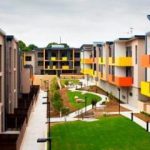The dress and the rabbit

“The dress” was a 2015 online viral phenomenon centred on a photograph of a dress. Viewers disagreed on whether the dress was blue and black, or white and gold. The phenomenon revealed differences in human colour perception and became the subject of scientific investigations into neuroscience and vision science.
The problem stemmed from the fact that the original was created digitally and grossly over-exposed. This meant that the colours were all present but presented in an unfamiliar way to the brain.
Take the image above. ‘B’ is assumed by the observer to be in shade and therefore the brain automatically compensates. In fact, both ‘A’ and ‘B’ are the same shade (cover the rest of the image to check).
What I found remarkable from this image was that you basically locked in to your perception. You can’t switch, undo it.
This is not like those old-fashioned optical illusions, where the drawing can either be an old woman or a young woman or the duck or rabbit?
If you know about both, you can pretty easily go back and forth between seeing the two versions—it’s a duck’s bill or it’s a rabbit’s ears; it’s a duck, a rabbit, a duck. In this instance with the dress, a single person can’t see both versions.
Our brains are constantly making assumptions about the images transmitted from our eyes. If, say, it’s near sunset, and the light is getting dim. And then, we see a fire engine come down the road. Probably we are going to assume that it’s red. That’s called the true-colour effect.
Our brain is constantly colour correcting. As the day progresses, the mix of wavelengths that reaches us from the atmosphere, they shift from, like, bluish during the day [to], in dusk, more reddish. So as these shift, our brain has to take that into account.
One scientist, Pascal surmised that over their lifetime, early birds get more short-wavelength blueish natural sunlight. On the other hand, people who stay up late get more long-wavelength artificial light.
In other words, he used chronotypes as proxies for what assumptions our brain was subconsciously making about the ambiguity of the lighting.
Larks should be more likely to see “the dress” as white. They’re going to fall back on the assumption that it’s the brighter outdoor light. They see a lot of that kind of light. So they’ll correct for the shadow effect so that it appears white. Meanwhile owls will be more likely to see it as blue. Their brain will assume it’s the kind of incandescent light they see inside at night. And under that kind of light, the dress is blue.
He tested this theory with a sample of about 1,000 people, many of whom he recruited from an article he published in Slate. What he found is the more you identify as a night owl, the more black and blue you think that image is—it’s a dose-dependent effect. These are very, very strong effects.
This would indicate that two people, standing side by side viewing the same scene would see slightly different images. Taken a step further, I have found that my diary recollections of travels around Australia differ markedly from those of my wife. In the past I have assumed this was because of differing interests but it now seems that our brains concentrate more on what we have learned to expect from past experiences.
Some years ago it was decided to test the results of ‘scientific assessment’. They gave 29 research teams the same dataset. The goal was to use data to answer this question: do soccer referees give more red cards to dark-skinned players than light-skinned ones.
Twenty teams concluded that soccer referees give more red cards to dark-skinned players, and nine teams found no significant relationship between skin colour and red cards. They were all using their best judgement to do the analysis, using the same data, but their answers were different.
The main takeaway is just that these decisions that are made as researchers are consequential. They matter more than we often assume they do. And not only do they matter, but they matter in ways that maybe we wouldn’t anticipate going in.
We need to be maybe a little less confident in our high-level, conceptual-level conclusions from any given study of any given topic—and a little more open to the idea that we may not have an answer for a while until we’ve tried this in a bunch of different ways with a bunch of different groups of people, a bunch of different analytical approaches, and so on. That is really the only way we’re going to get a real firm handle on what’s going on.
What we should be learning from this is that uncertainty or variability is just part of the scientific process. All science is provisional—there’s no hard end point. It is not a collection of facts despite what you may have been taught in high school. It’s a process. We cannot be certain of anything unless we test and test and test.

Alan Stevenson spent four years in the Royal Australian Navy; four years at a seminary in Brisbane and the rest of his life in computers as an operator, programmer and systems analyst. His interests include popular science, travel, philosophy and writing for Open Forum.















